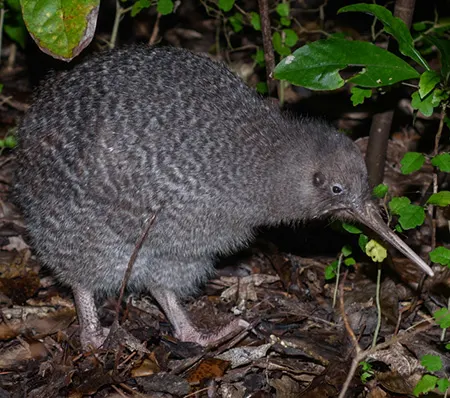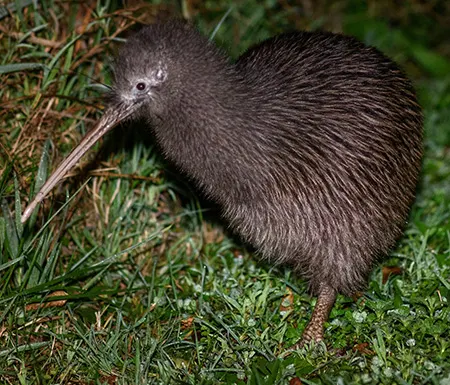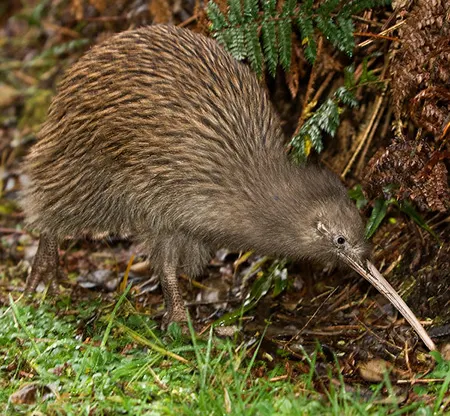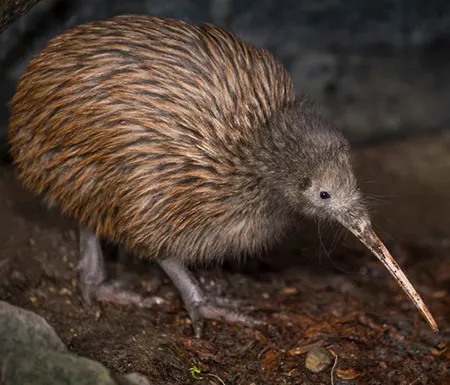
(Apterygiformes)
Kiwis
Ківіподібні
Kiwi are flightless birds endemic to New Zealand of the order Apterygiformes. The five extant species fall into the family Apterygidae and genus Apteryx. Approximately the size of a domestic chicken, kiwi are the smallest ratites.
DNA sequence comparisons have yielded the conclusion that kiwi are much more closely related to the extinct Malagasy elephant birds than to the moa with which they shared New Zealand. There are five recognised species, four of which are currently listed as vulnerable, and one of which is near threatened. All species have been negatively affected by historic deforestation, but their remaining habitat is well protected in large forest reserves and national parks. At present, the greatest threat to their survival is predation by invasive mammalian predators.
Description
Their adaptation to a terrestrial life is extensive: like all the other ratites (ostrich, emu, rhea and cassowary), they have no keel on the sternum to anchor wing muscles. The vestigial wings are so small that they are invisible under the bristly, hair-like, two-branched feathers. While most adult birds have bones with hollow insides to minimise weight and make flight practicable, kiwi have marrow, like mammals and the young of other birds. Like most other ratites, they have no uropygial gland (preen gland). Their bill is long, pliable and sensitive to touch, and their eyes have a reduced pecten. Their feathers lack barbules and aftershafts, and they have large vibrissae around the gape. They have 13 flight feathers, no tail and a small pygostyle. Their gizzard is weak and their caecum is long and narrow.
The eye of the kiwi is the smallest relative to body mass in all avian species, resulting in the smallest visual field as well. The eye has small specialisations for a nocturnal lifestyle, but kiwi rely more heavily on their other senses (auditory, olfactory, and somatosensory system). The sight of the kiwi is so underdeveloped that blind specimens have been observed in nature, showing how little they rely on sight for survival and foraging. In an experiment, it was observed that one-third of a population of A. rowi in New Zealand under no environmental stress had ocular lesions in one or both eyes. The same experiment examined three specific specimens that showed complete blindness and found them to be in good physical standing outside of ocular abnormalities.
Unlike virtually every other palaeognath, which are generally small-brained by bird standards, kiwi have proportionally large encephalisation quotients. Hemisphere proportions are even similar to those of parrots and songbirds, though there is no evidence of similarly complex behaviour.
Behaviour and ecology
Before the arrival of humans in the 13th century or earlier, New Zealand’s only endemic mammals were three species of bat, and the ecological niches that in other parts of the world were filled by creatures as diverse as horses, wolves and mice were taken up by birds (and, to a lesser extent, reptiles, insects and gastropods).
The kiwi’s mostly nocturnal habits may be a result of habitat intrusion by predators, including humans. In areas of New Zealand where introduced predators have been removed, such as sanctuaries, kiwi are often seen in daylight. They prefer subtropical and temperate podocarp and beech forests, but they are being forced to adapt to different habitat, such as sub-alpine scrub, tussock grassland, and the mountains. Kiwi have a highly developed sense of smell, unusual in a bird, and are the only birds with nostrils at the end of their long beaks. Kiwi eat small invertebrates, seeds, grubs, and many varieties of worms. They also may eat fruit, small crayfish, eels and amphibians. Because their nostrils are located at the end of their long beaks, kiwi can locate insects and worms underground using their keen sense of smell, without actually seeing or feeling them. This sense of smell is due to a highly developed olfactory chamber and surrounding regions. It is a common belief that the kiwi relies solely on its sense of smell to catch prey, but this has not been scientifically observed. Lab experiments have suggested that A. australis can rely on olfaction alone but is not consistent under natural conditions. Instead, the kiwi may rely on auditory and/or vibrotactile cues.
Mating and breeding
Once bonded, a male and female kiwi tend to live their entire lives as a monogamous couple. During the mating season, June to March, the pair call to each other at night, and meet in the nesting burrow every three days. These relationships may last for up to 20 years. They are unusual among other birds in that, along with some raptors, they have a functioning pair of ovaries. (In most birds and in platypuses, the right ovary never matures, so that only the left is functional.)
Usually, only one egg is laid per season. The kiwi lays one of the largest eggs in proportion to its size of any bird in the world, so even though the kiwi is about the size of a domestic chicken, it is able to lay eggs that are about six times the size of a chicken’s egg. Kiwi eggs can weigh up to one-quarter the weight of the female, helped by their inability to fly that could limit the extent by its body weight; brown kiwi females carry and lay a single egg that may weigh as much as 450 g. The eggs are smooth in texture, and are ivory or greenish white. The male incubates the egg, except for the great spotted kiwi, A. haastii, in which both parents are involved. The incubation period is 63–92 days. Producing the huge egg places significant physiological stress on the female; for the thirty days it takes to grow the fully developed egg, the female must eat three times her normal amount of food. Two to three days before the egg is laid there is little space left inside the female for her stomach and she is forced to fast.
It was believed that the large eggs were a trait of much larger moa-like ancestors, and that kiwi retained large eggs as an evolutionarily neutral trait as they became smaller. However, research in the early 2010s suggested that kiwi were descended from smaller flighted birds that flew to New Zealand and Madagascar, where they gave rise to kiwi and elephant birds. The large egg is instead thought to be an adaptation for precocity, enabling kiwi chicks to hatch mobile and with yolk to sustain them for two and half weeks. The large eggs would be safe in New Zealand’s historical absence of egg-eating ground predators, while the mobile chicks would be able to evade chick-eating flying predators.

(Apteryx maxima)
Great Spotted Kiwi
Ківі сірий
It is endemic to New Zealand and inhabits higher elevations in the northern part of the South Island, ranging from sea level up to 1,500 m.

(Apteryx owenii)
Little Spotted Kiwi
Ківі малий
It is endemic to New Zealand and, in pre-European times, occurred on both main islands. Today, it is mainly restricted to 8 small islands, with two remaining subpopulations on the North Island.

(Apteryx rowi)
Okarito Kiwi
Ківі окаритський
It is found in a restricted area of the Ōkārito forest on the West Coast of New Zealand’s South Island, and has a population of only about 600 birds.

(Apteryx australis)
Southern Brown Kiwi
Ківі бурий
It lives on the South Island and Stewart Island. On the South Island, it is found in Fiordland and Westland. Its range includes temperate and subtropical forests, grasslands, and shrublands.

(Apteryx mantelli)
North Island Brown Kiwi
Ківі північний
It inhabits four primary regions within New Zealand’s North Island. They are Northland and its associated islands, the Coromandel, eastern North Island and western North Island.

